
Seguimos hablando de Shikanoshima, esta vez desde el Kin’in Kōen, o Parque del Sello de Oro.
志賀島の話がまだ続きます。今回は金印公園より。
Still writing about Shikanoshima! Today it’s right from Kin’in Kōen, or the Gold Seal Park.

Es un parque que conmemora el hallazgo en esta pequeña isla del sello del «Rey de Nanokuni«, supuestamente regalado por Guangwu (primer emperador de la dinastía china de los Han Posteriores u Orientales) al rey del pequeño país japonés Nanokuni. Todo esto ocurrió hace unos 2000 años.
漢委奴国王印がこの島で出土されたことを記念する公園です。中国の後漢王朝の光武帝が奴国という日本にあった小さな国の王に贈ったらしい。これは約2000年前の話です。
It’s a park made to commemorate the finding of the seal of the «King of Nanokuni» in Shikanoshima, which was purportedly given to the king of Nanokuni (a small country there was in Japan) by Guangwu, first emperor of the chinese Later Han (or Eastern Han) dinasty. All of this took place about 2000 years ago.

Lo de las fotos de arriba, por supuesto, eran réplicas a escala. El sello de oro se encontró en 1784 en Shikanoshima, y tiene estas dimensiones.
上の写真はもちろん大きいレプリカです。金印は1784年に志賀島で発見されて、この大きさです。
The pictures above are of huge replicas. The real seal was found in 1784 in Shikanoshima and is this size.

Se usaba para marcar la correspondencia, como los sellos de lacre, pero parece ser que usaban arcilla.
通信品などを粘土で封印するのに使われていたらしい。
It was used for sealing correspondence. They didn’t use sealing wax but clay.

El sello de oro es un símbolo del contacto de Japón con China.
金印は中国と日本の接触の象徴です。
The gold seal is a symbol of contact between Japan and China.

Está en casi todos los libros de texto de historia, e incluso aparece en el primer tomo de este manga de historia de Shōtarō Ishinomori, el autor de manga más prolífico de la historia, creador de Kamen Rider y gran contribuyente al legado TLQM.
歴史の教科書には大体載っていますし、石ノ森章太郎の「マンガ日本の歴史」にも登場する。
It’s on almost every History textbook, and it even appears on this manga about history by Shōtarō Ishinomori, creator of Kamen Rider and most prolific manga author.

Próximamente reseña en pepinismo.
近いうちにpepinismoでレビューしたい。
Soon to be reviewed at pepinismo.

Si os interesan la historia, la naturaleza o la cultura japonesas, Shikanoshima es un buen sitio para visitar en una mañana o una tarde.
日本の歴史、自然、文化に興味があるなら、志賀島で半日を過ごしても損がないでしょう。
You won’t be losing your time by spending a morning or afternoon visiting Shikanoshima, if you are interested in Japan’s history, nature or culture.




























